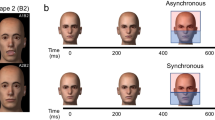Abstract
The effects of movement on the recognition of famous faces shown in difficult conditions were investigated. Images were presented as negatives, upside down (inverted), andthresholded. Results indicate that, under all these conditions, moving faces were recognized significantly better than static ones. One possible explanation of this effect could be that a moving sequence contains more static information about the different views and expressions of the face than does a single static image. However, even when the amount of static information was equated (Experiments 3 and 4), there was still an advantage for moving sequences that contained their original dynamic properties. The results suggest that the dynamics of the motion provide additional information, helping to access an established familiar face representation. Both the theoretical and the practical implications for these findings are discussed.
Similar content being viewed by others
References
Bassili, J. N. (1978). Facial motion in the perception of faces and emotional expression.Journal of Experimental Psychology: Human Perception & Performance,4, 373–379.
Bassili, J. N. (1979). Emotion recognition: The role of facial movement and the relative importance of the upper and lower areas of the face.Journal of Personality & Social Psychology,37, 2049–2058.
Brennen, T., Baguley, T., Bright, J., &Bruce, V. (1990). Resolving semantically induced tip-of-the-tongue states for proper nouns.Memory & Cognition,18, 339–347.
Bruce, V., Hanna, E., Dench, N., Healey, P., &Burton, M. (1992). The importance of ‘mass’ in line drawings of faces.Applied Cognitive Psychology,6, 619–628.
Bruce, V., &Langton, S. (1994). The use of pigmentation and shading information in recognizing the sex and identities of faces.Perception,23, 803–822.
Bruce, V., &Valentine, T. (1988). When a nod’s as good as a wink: The role of dynamic information in facial recognition. In M. M. Gruneberg & E. Morris (Eds.),Practical aspects of memory: Current research and issues (pp. 169–174). Hillsdale, NJ: Erlbaum.
Bruce, V., &Young, A. W. (1986). Understanding face recognition.British Journal of Psychology,77, 305–327.
Burton, A. M., Bruce, V., &Johnston, R. A. (1990). Understanding face recognition with an interactive activation model.British Journal of Psychology,81, 361–380.
Burton, A. M., Wilson, S., Cowan, M., &Bruce, V. (1999). Face recognition in poor-quality video: Evidence from security surveillance.Psychological Science,10, 243–248.
Christie, F., &Bruce, V. (1998). The role of dynamic information in the recognition of unfamiliar faces.Memory & Cognition,26, 780–790.
Hanley, J. R., &Cowell, E. S. (1988). The effects of different types of retrieval cues on the recall of names of famous faces.Memory & Cognition,16, 545–555.
Hay, D. C., &Young, A. W. (1982). The human face. In A. W. Ellis (Ed.),Normality and pathology in cognitive functions (pp. 173–202). London: Academic Press.
Johansson, G. (1973). Visual perception of biological motion and a model for its analysis.Perception & Psychophysics,14, 201–211.
Kemp, R., McManus, C., &Pigott, T. (1990). Sensitivity to the displacement of facial features in negative and inverted images.Perception,19, 531–543.
Kemp, R., Pike, G., White, P., &Musselman, A. (1996). Perception and recognition of normal and negative faces: The role of shape from shading and pigmentation cues.Perception,25, 37–52.
Knight, B., &Johnston, A. (1997). The role of movement in face recognition.Visual Cognition,4, 265–273.
Lander, K. (1999).The role of movement in the recognition of famous faces. Unpublished doctoral thesis.
Lander, K., Bruce, V., & Hill, H. (1999).Evaluating the effectiveness of pixelation and blurring on masking the identity of familiar faces. Manuscript submitted for publication.
Pike, G. E., Kemp, R. I., Towell, N. A., &Phillips, K. C. (1997). Recognising moving faces: The relative contribution of motion and perspective view information.Visual Cognition,4, 409–437.
Schiff, W., Banka, L., &De Bordes Galdi, G. (1986). Recognising people seen in events via dynamic “mugshots.”American Journal of Psychology,99, 219–231.
Snodgrass, J. G., &Corwin, J. (1988). Pragmatics of measuring recognition memory: Applications to dementia and amnesia.Journal of Experimental Psychology: General,117, 34–50.
Tanaka, J. W., &Farah, M. J. (1993). Parts and wholes in face recognition.Quarterly Journal of Experimental Psychology,46, 225–245.
Yarmey, A. D. (1973). I recognize your face but I can’t remember your name: Further evidence on the tip-of-the-tongue phenomenon.Memory & Cognition,1, 287–290.
Young, A. W., Hay, D. C., &Ellis, A. W. (1985). The faces that launched a thousand slips.British Journal of Psychology,76, 495–523.
Author information
Authors and Affiliations
Corresponding author
Additional information
K.L. was supported by a University of Stirling Ph.D. studentship. V.B.’s research was supported by ESRC Grant R000 23 66 88.
Rights and permissions
About this article
Cite this article
Lander, K., Christie, F. & Bruce, V. The role of movement in the recognition of famous faces. Mem Cogn 27, 974–985 (1999). https://doi.org/10.3758/BF03201228
Received:
Accepted:
Published:
Issue Date:
DOI: https://doi.org/10.3758/BF03201228




